We’ve all been there. Whether we leave the lights on or left the battery on with the engine off, a dead battery is a sure way of messing up a schedule and putting a big dent in the day. A dead battery means trying to wave down another vehicle who hopefully has jumper cables, calling a friend, or a car service who can come give your car a jump. Either way, you’ll need to know how to jump the car so that you can get on with your day. Here’s how to jump a car battery, instructions from the expert mechanics at NW AutoFix in Aloha.
Tools
In order to jump a car battery, there are a few things that you will need. First, a working vehicle. Second, jumper cables. Jumper cables are the most common method of jumping a car because they are inexpensive and easy to keep in the trunk of a car. They are typically between 10 and 20 feet and there are also a variety of gauge thicknesses. The gauge is how strong the cable is, the lower the number, the stronger they are. For jumper cables, gauge six is the standard size.
Safety First
When jumping a car, it’s important to understand that the cables are transferring electric current from the running car to the dead car’s battery.
- When one end of the jumper cables is in contact with the running car, don’t touch the metal clamps on the jumper cables to anything except the correct parts on the dead car’s battery.
- If you have any questions about the steps of jumping a car, please feel free to give a mechanic at NW AutoFix a call.
How to Jump a Car
- Place the running car next to the dead car so that the hoods are as close as possible, but not touching each other. Put automatic transmission cars in park, and put manual transmission cars in neutral with the parking brake on.
- Both cars should be off and the keys should not be in the ignition.
- Open the hoods of the cars and locate the battery. Identify the two terminals, which are typically covered in red or black with a + or – sign. Determining which terminal is positive and which is negative is crucial to a successful jump.
- Attach the positive, red cable clamp to the positive battery terminal of the dead battery.
- Attach the other positive, red clamp on the opposite end of the cables to the positive terminal on the running car’s battery.
- Attach the black, negative clamp to the negative battery terminal on the running car’s battery.
- On the dead vehicle, attach the remaining clamp to an unpainted, metal part of the car, such as a clean nut on the engine block.
- Start the working car.
- Depending on how long the battery has been dead, the working car may need to run for a minute or two.
- Start the dead vehicle. If it still does not start, let the working vehicle run a while longer and try again.
- When the dead car starts, begin disconnecting the clamps, starting with the black, negative clamp.
- Never let the clamps touch each other while they are still attached to the vehicle.
- Allow the newly running car to run for a while to ensure the alternator fully charges the battery.
Jumping a car is relatively simple, just be sure to start attaching the cables to the positive ends first. If you have any questions, or the jump did not start the car and you need professional assistance, contact a mechanic who can diagnose the problem.
At NW AutoFix, we can assure you that we will give a professional and reliable opinion. Give us a call today with any of your repair or service needs.





Comments are closed.